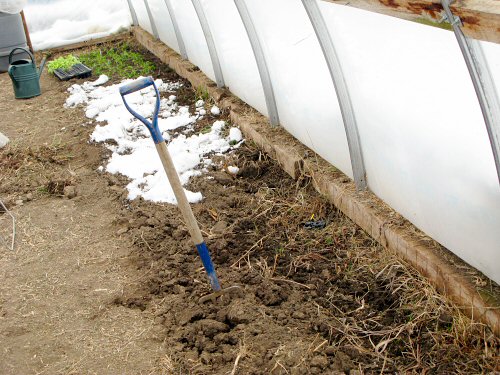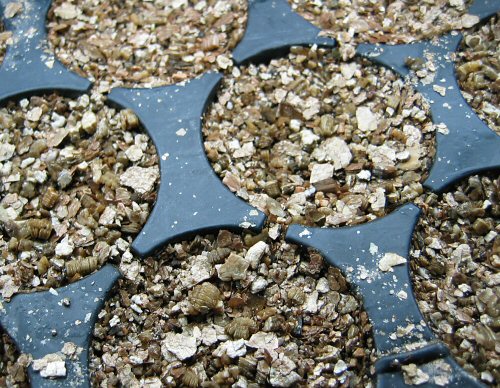
Taking advantage of the cloudy weather, I moved all of the lettuce out to the greenhouse for some rapid hardening off, and started prepping more ground for transplanting. At the edges, there’s lots of dead grass, and I’ve already pulled out a fair tangle of well-established live grass runners. The grass grows in from outside; the runners are incredibly busy and invasive, and can build up underground and, from what I’ve seen, seem able to noticeably sap resources from the plants above, even when the grass itself hasn’t broken through. This is an observation in progress (more on this later as I prep the field with its grassy paths). For now, I’m slicing deep with an edger right by the boards (if I get the chance sometime during the year, I’ll clear a grass-free strip around the outside of the hoophouse). Anyhow, lettuce will soon be in!




Is there anything you can use to kill the grass, or is it just a case of dig it all out?
I’m looking at all the weeding I have to do and wondering if I will ever be able to get on top of it.
I’d spray some Roundup around the outside perimeter of the greenhouse–it kills the roots too so it keeps it from creeping in under the edge. On the list of toxic chemicals its very benign– an LD-50 of something like 4,000 with things like Temik, Black Leaf-40, and Parathion being quite low (below 100) and water having an LD-50 of around 10,000. The lower the LD-50 the more toxic the product. Of course if you have issues with Monsanto then you might not want to use it…
I have exactly the same problem. Doing the same thing. Hoping to clear a strip around the outside and possible put down weed cloth and pile rocks on it. The weed cloth I used to have on the inside floor had weeds growing thru it! Great weed cloth huh?! Lisa
I don’t think you can use glyphosates on an organic farm?
Anyways, killing the grass with roundup would only allow more intrusive weeds to grow there instead, unless you laid down bark, gravel etc.
That was my thought even though glyphosates are supposed to break down in the soil.
I have used Roundup but I do have a few misgivings about Monsanto as a company too
Where I’ve planted the fruit orchard, the straw mulch is working reasonably well but strong things like dandelions are forcing their way through. I also used thick black plastic to good effect but it does take a year to work.
Monsanto products in an organic garden…oh my god! ;)
Glyphosates are strictly verboten according to organic production standards, as far as certification is concerned. Personally, though, I’m just not interested, so I haven’t so far ever even vaguely wondered how much “easier” it might be to bring on the pesticides. I guess for me it’s knowing that anything I sprayed would be killing off more than its target, and that would somehow affect the soil balance that I’m slowly learning to feel/understand, and I’d lose any natural frame of reference. Luckily, I haven’t been overrun by anything: weeds, bugs, disease. If I had crops completely wiped out by something I couldn’t stop with row cover, or replanting, or hand picking, my faith in organic ways might be a little shaken. Who knows? Anything’s possible. But not so far! :)
For the grass-free strips, I’ll probably lay down some cover after it’s cleared, like heavy opaque plastic under gravel…
Mike,
I’ve used wood chips for this purpose with some success. The benefit over plastic and gravel is that they aren’t as permanent. I’ve had to remove gravel placed in ill-conceived flower beds and it’s not fun. Despite the plastic, in a couple years you’ll get some super hardy weeds growing in the gravel. I get a lot of wood chips free from tree removal companies (they even deliver it and thank me!!). It would be perfect for what you’re doing.
Chris
Chris: Wood chips sound good! I’ll look into it. They could work a couple of other places as well…
That does bring up an interesting conundrum for those who are mainly organic but occasionally bring in the heavy stuff…my job is now taking care of the greenhouses at the Fort Worth Botanic Garden and our philosophy is to use the minimum necessary to control pests. That means insecticidal soap, neem oil, and the like, in addition to lacewing larvae, geckos, etc. for biological control. But every once in a while the whitefly, mealybug, and scale just plain overrun things and a more potent chemical may be indicated.
It is a difficult choice. I’m not organic but would like to be in principle. However I’m looking at 2 acres of couch grass to clear before I can get this year’s crops in, and there is just me to do it.
Decisions, decisions, and I thought gardens were meant to be therapeutic and calming!
Yeah, I guess this 100% “organic” growing can be a bit of a puzzle. I’m luckily in the position I described in my comment above: since I haven’t run into anything that I couldn’t quite easily handle with the most basic organic pest controls—row cover, hand picking and weeding, tillage, taking the loss—I haven’t had to make tough decisions (knock on wood!). Also, there are rotenone, pyrethrin and BT, all approved organic insecticides that are apparently pretty decisive, and sulphur and copper fungicides, and these I have in the back of my mind in case DRASTIC MEASURES are called for.
Deborah, I hadn’t thought of QUACK GRASS (couch grass) in a while. That was one of the nightmare afflictions I read about when starting out, I examined just about every blade of grass that appeared in the garden for quite a while (after I discovered ID-by-clasping auricle!), JUST IN CASE… Anyhow, there’s none here, but what if there had been? In this particular case, from what I’ve read and heard, it’s either glyphosate or an incredible amount of digging and weeding, possibly for, like, YEARS! Or stripping and replacing the topsoil. Or laying down, well, acres of plastic for a long while. Say I don’t have a problem, in this extreme situation, with “just this once”, would I afterwards lie about doing it, or give up certification…? And would I feel I’d cheated (personally, not with the regulations), would that affect everything else? Because I think that, when starting out, “organic” growing is in good part a state of mind that lets you happily take a lot of what could seem in the short run more difficult approaches, while somehow not even paying much attention to conveniences like…chemicals. I mean, I understand and I FEEL the arguments against chemical approaches, the shortsightedness, the awful industrial ag conditions that exist, all of that, but for me, with no first-hand experience in that world, it’s all abstraction. When it comes down to reliably producing food, and something’s going wrong, well, you get pretty PRACTICAL in your thinking… You don’t want to be doubting the effectiveness what you’re doing…
So, I dunno. If I was starting up, and wasn’t going to be certified, and was faced with acres of rampant quackgrass, and considering the RELATIVE…benignity of glyphosate that’s widely reported (both scientifically and farmer-first-hand), I could see taking that course. And I’d tell people/customers (“I used…one time…”), at least, for a year or two after the fact (that’s just me).
Right now, though, a few years in, it wouldn’t be that easy, and mainly for internal reasons, more than that I actually think it would be a physically bad thing in that limited situation. Luckily, nothing like that is on my plate right now!! I’d decide for myself when the time came… (I should add, I’m quiet skeptical of organic certification as a regulatory framework, the standards are great, the rest is really…corporate big business.)
I’m not sure what kind of comment that is, if I conveyed what I’m thinking, but I’ll post it… :)
If the grass is sending out runners, Round-Up will be less effective even if you are considering it. I have also seen studies that it crosses the placental wall in pregnant women… it is not something am comfortable with. In quack grass it only kills until the first unsprayed “node” and I have pulled up rhizomes over 14′ long with a leafing node every 1′ or so. I would recommend (in your spare time…HA!) forking the perimeter of the greenhouse to remove the rhizomes by hand, and then putting in a physical barrier like roof flashing or something to send any new runners up and out of the soil. 12″ down, and angled up and towards the greenhouse with the top edge resting well l above soil level to get the runners airborne and dead should do it. Similar barriers (but deeper) work on bamboo groves. The only thing I have found to out compete Quack and other aggressive rhizomitous grasses is dutch white clover, which is equally aggressive, but as it spread by stolons (above the ground) it is easily to contain and should not invade. Also, cut clover makes great nitrogen rich mulch, and really good addition to chicken feed. Buckwheat or better yet, Sudan/Sorghum grass might smother it as well and would give you a great mulch harvest.
Not only is the grass sucking nutrients, it might be slightly alleopathic. I try not to hate any plant… but quack pushes my limits. On the upside it is a great pasture and erosion control grass…
-Rob
Well Mike, this post has produced some interesting thoughts.
I think I’ve decided what to do. Firstly I’m not going to go down the registered organic route. I would like to do the certified naturally grown route you suggested but that doesn’t exist in France. I have too much couch grass to weed by hand this year so I will spray with the aim of making it one time only. Most people buy from the markets herer without a though to organic or not so I don’t think it will harm potential sales but I can then continue to work towards my own aim to a more permaculture approach.
One final thought on couch grass, somewhere in the dim recesses of my mind I remember reading that tomatoes, or rather their roots, can discourage it. I’ll have to trawl through some of my books (yes it’s that far back it has to be books and not online) and see if I can find it again. I’m sure it’s along with something on companion planting which is something else I want to do.
Deborah: I’m sure you’ve done a lot of research on this quackgrass thing, but here’s a really brief but detailed page, Controlling quackgrass in gardens, covering both chem and non-chemical controls. It has some useful details, including smother crops and the dormant bud issue, both mentioned by Rob, above. Just reading about this stuff again gave me a shiver: a dense mat 4″ thick of tangled runners, holy heck!
not sure about this, but fruit farms have been known to sow Yellow Rattle, Rhinanthus minor, between the rows as this herb behaves parasitically on grasses, weakening them.
Worth a try, I’m giving it a shot this year and we’ll see how it goes
Round-up definitely a “practical” response to quackgrass
but you sure dont want to be representing it as organic
(even in Texas)